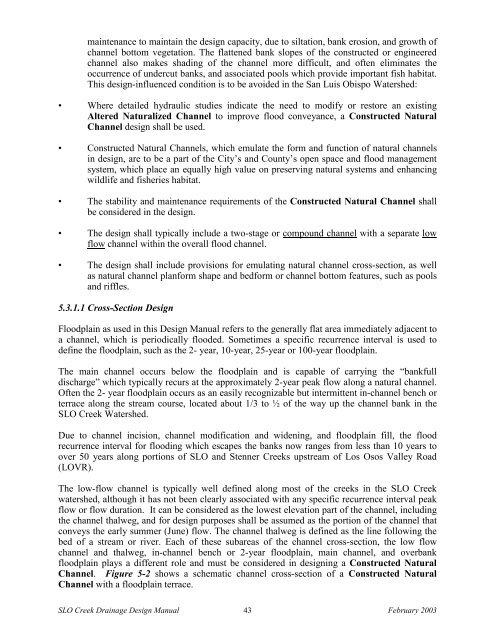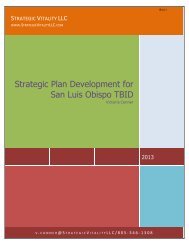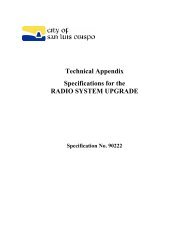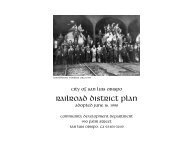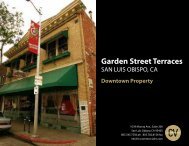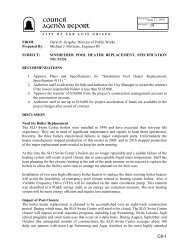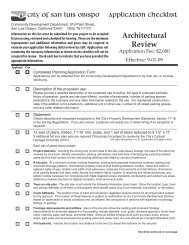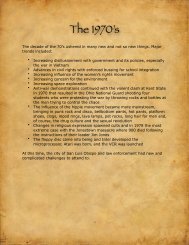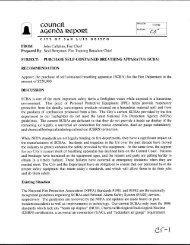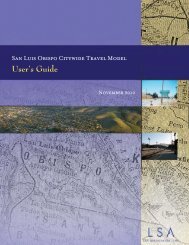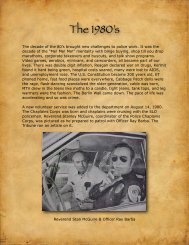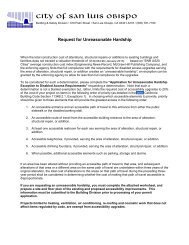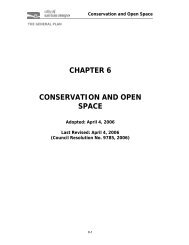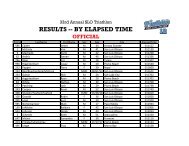Drainage Design Manual - the City of San Luis Obispo
Drainage Design Manual - the City of San Luis Obispo
Drainage Design Manual - the City of San Luis Obispo
Create successful ePaper yourself
Turn your PDF publications into a flip-book with our unique Google optimized e-Paper software.
maintenance to maintain <strong>the</strong> design capacity, due to siltation, bank erosion, and growth <strong>of</strong>channel bottom vegetation. The flattened bank slopes <strong>of</strong> <strong>the</strong> constructed or engineeredchannel also makes shading <strong>of</strong> <strong>the</strong> channel more difficult, and <strong>of</strong>ten eliminates <strong>the</strong>occurrence <strong>of</strong> undercut banks, and associated pools which provide important fish habitat.This design-influenced condition is to be avoided in <strong>the</strong> <strong>San</strong> <strong>Luis</strong> <strong>Obispo</strong> Watershed:• Where detailed hydraulic studies indicate <strong>the</strong> need to modify or restore an existingAltered Naturalized Channel to improve flood conveyance, a Constructed NaturalChannel design shall be used.• Constructed Natural Channels, which emulate <strong>the</strong> form and function <strong>of</strong> natural channelsin design, are to be a part <strong>of</strong> <strong>the</strong> <strong>City</strong>’s and County’s open space and flood managementsystem, which place an equally high value on preserving natural systems and enhancingwildlife and fisheries habitat.• The stability and maintenance requirements <strong>of</strong> <strong>the</strong> Constructed Natural Channel shallbe considered in <strong>the</strong> design.• The design shall typically include a two-stage or compound channel with a separate lowflow channel within <strong>the</strong> overall flood channel.• The design shall include provisions for emulating natural channel cross-section, as wellas natural channel planform shape and bedform or channel bottom features, such as poolsand riffles.5.3.1.1 Cross-Section <strong>Design</strong>Floodplain as used in this <strong>Design</strong> <strong>Manual</strong> refers to <strong>the</strong> generally flat area immediately adjacent toa channel, which is periodically flooded. Sometimes a specific recurrence interval is used todefine <strong>the</strong> floodplain, such as <strong>the</strong> 2- year, 10-year, 25-year or 100-year floodplain.The main channel occurs below <strong>the</strong> floodplain and is capable <strong>of</strong> carrying <strong>the</strong> “bankfulldischarge” which typically recurs at <strong>the</strong> approximately 2-year peak flow along a natural channel.Often <strong>the</strong> 2- year floodplain occurs as an easily recognizable but intermittent in-channel bench orterrace along <strong>the</strong> stream course, located about 1/3 to ½ <strong>of</strong> <strong>the</strong> way up <strong>the</strong> channel bank in <strong>the</strong>SLO Creek Watershed.Due to channel incision, channel modification and widening, and floodplain fill, <strong>the</strong> floodrecurrence interval for flooding which escapes <strong>the</strong> banks now ranges from less than 10 years toover 50 years along portions <strong>of</strong> SLO and Stenner Creeks upstream <strong>of</strong> Los Osos Valley Road(LOVR).The low-flow channel is typically well defined along most <strong>of</strong> <strong>the</strong> creeks in <strong>the</strong> SLO Creekwatershed, although it has not been clearly associated with any specific recurrence interval peakflow or flow duration. It can be considered as <strong>the</strong> lowest elevation part <strong>of</strong> <strong>the</strong> channel, including<strong>the</strong> channel thalweg, and for design purposes shall be assumed as <strong>the</strong> portion <strong>of</strong> <strong>the</strong> channel thatconveys <strong>the</strong> early summer (June) flow. The channel thalweg is defined as <strong>the</strong> line following <strong>the</strong>bed <strong>of</strong> a stream or river. Each <strong>of</strong> <strong>the</strong>se subareas <strong>of</strong> <strong>the</strong> channel cross-section, <strong>the</strong> low flowchannel and thalweg, in-channel bench or 2-year floodplain, main channel, and overbankfloodplain plays a different role and must be considered in designing a Constructed NaturalChannel. Figure 5-2 shows a schematic channel cross-section <strong>of</strong> a Constructed NaturalChannel with a floodplain terrace.SLO Creek <strong>Drainage</strong> <strong>Design</strong> <strong>Manual</strong> 43 February 2003


